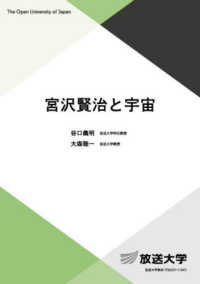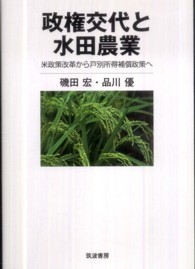- ホーム
- > 洋書
- > ドイツ書
- > Humanities, Arts & Music
- > History
- > prehistory
基本説明
This volume is based on a session at the Society for Historical Archaeology meeting in 2005. The organizers - now editors - brought together historical archaeologists from both the UK and the US working in the same areas (industrial landscape, monuments, etc.) but because of their country-based training, their work arises out of differing intellectual traditions.
Full Description
Interpretive archaeology - meaning the interpretation (social science as opposed to hard science) of archaeology and archaeological artifacts - has predominantly been the realm of prehistoric archaeologists. Many historical archaeologists are participating in this disciplinary shift from processualism to post-processualism and interpretation, but to date few have called their work interpretive archaeology.
This volume is based on a session at the Society for Historical Archaeology meeting in 2005. The organizers - now editors - brought together historical archaeologists from both the UK and the US working in the same areas (industrial landscape, monuments, etc.) but because of their country-based training, their work arises out of differing intellectual traditions. The chapters in each section do not stand in isolation; rather, the authors exchange ideas about what each other has written. They construct dialogues about theories and practices that inform interpretive archaeology on either side of the Atlantic, ends with commentary by two well-known names in interpretive archaeology in the UK and in the States.
Contents
Part I. Country Estates/Landscapes: An American Landscape Conversation.- The Archaeology of Estate Landscapes in Eighteenth-Century England.- Part II. Archaeology of 19th century and the Lives of Working People: Section Introduction.- Urban Historical Archaeology: A View from the Golden Gate.- Celebrating Steel City: Historical Archaeology in Sheffield, U.K.- Part III. Conflict and Memorialization: Section Introduction.- "Remembering the Raid of 1704": Writing and Exhibiting Contested Histories in Historic Deerfield.- Monuments, Memory, and Resistance in the Scottish Highlands.- Part IV. Material Culture, Embodiment, Life Course, Identity: Section Introduction.- Stitching Women's Loves: Interpreting the Artifacts of Sewing and Needlework.- The Intimacy of Death: Expressions of Identity and Grief in Medieval and Renaissance Burial Rites.- Part V. Industrial Housing/Landscapes: Section Introduction.- "You Knew Where you Were": Practicing Class in (Post) Industrial Cheshire.- The Study of the Early Industrial Landscapes of the Swansea Region.- Part VI. Archaeological Biographies: Section Introduction.- The Large Writ Small: Landscape, Archaeography, and the Battle for Meaning.- Biographies of Long Life. Part VII. Commentary.








